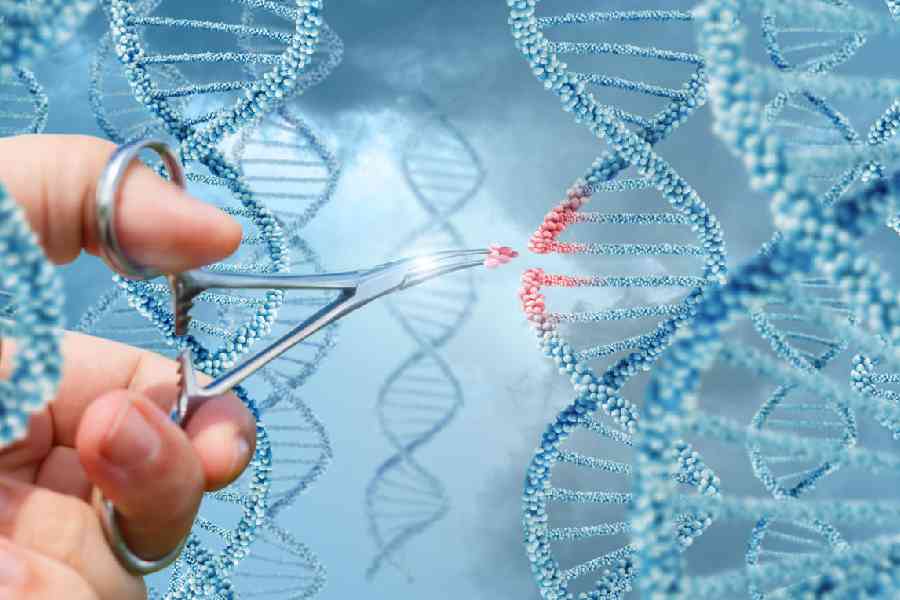Researchers have corrected a disease-causing gene mutation with a single infusion carrying a treatment that precisely targeted the errant gene. This was the first time a mutated gene had been restored to normal.
The small study of nine patients announced recently by Beam Therapeutics of Cambridge, Massachusetts, US, involved fixing a spelling error involving the four base sequences — G, A, C and T — in DNA. The effect was to change an incorrect DNA letter to the right one.
The result of this was a normal gene that functioned as it should, potentially halting liver and lung damage in patients with a rare genetic disorder.
Dr Kiran Musunuru, a gene therapy researcher at the University of Pennsylvania’s Perelman School of Medicine, US, said that the method offers the hope of treating other genetic diseases precisely by fixing mutations — an alternative to current gene therapies, which either add new genes to compensate for mutated ones or slice DNA to silence genes.
Dr Richard P. Lifton, president of Rockefeller University, US, and head of its Laboratory of Human Genetics and Genomics, said the sort of gene editing Beam did, rewriting genes with an infusion, “is a holy grail” that “has the promise for being a one-and-done kind of therapy”.
Dr Lifton is a director of Roche Pharmaceuticals and its subsidiary Genentech.
Despite the study’s rather small size, he said the results are “a very impressive advance and very promising”.
The study involved patients who have alpha-1 antitrypsin deficiency, or AATD, a genetic disease that affects an estimated 1,00,000 Americans, mostly of European ancestry. That makes it as common as sickle cell in this country. It is progressive and incurable.
The alpha-1 antitrypsin protein is made in the liver and normally goes to the lungs and protects them from inflammation from inhaled irritants like smoke or dust. But in people with the disease, a single change in a DNA letter in the gene results in a misshapen and nonfunctional protein. The result is often emphysema or chronic obstructive pulmonary disease in unprotected lungs.
But many of the aberrant alpha-1 antitrypsin proteins never manage to get to the lungs and instead build up in patients’ livers, often causing cirrhosis.
The gene editing was simple for patients. They sat in a chair for a couple of hours while lipid nanoparticles, like those used in Covid vaccines, were infused into their blood. The nanoparticles did not hold vaccines, though. Instead, they encased a microscopic gene editor. The lipid casing protected the editor on a journey to the liver.
When the nanoparticles reached the liver, the lipid layer peeled off, releasing the editor — a disabled CRISPR molecule that acted like a GPS for the genome and an enzyme to fix the mutation. The CRISPR molecule crawled along the patient’s DNA until it found the one incorrect letter that needed to be repaired among the three billion DNA letters in the genome. Then the editing enzyme replaced that letter with the correct one.
The study divided the patients into three groups and tested three different doses of the gene editor. Those who got the highest dose made enough normal alpha-1 antitrypsin to be in a range where no more damage should occur. There were no serious side effects, said John Evans, Beam’s CEO.
Beam will now be offering the higher dose to the patients who got the lower doses in the company’s study. Beam will also study the treatment in more patients, and test a higher dose of its gene editor.
Dr Noel McElvaney, a professor at the Royal College of Surgeons in Ireland and an investigator in the Beam study, said there’s a real need for an effective treatment to halt the damage done by the mutated gene. He said he sees patients in their 30s and 40s with severe emphysema and “really bad liver disease”. And, he said, “by the time we see them there is already a significant amount of damage”.
For those suffering the worst effects of AATD, he said, the new gene therapy is “a major major breakthrough”.
“The big pro” of the new treatment, he said, is that “it theoretically cures the liver and lung disease in one go”.
NYTNS










